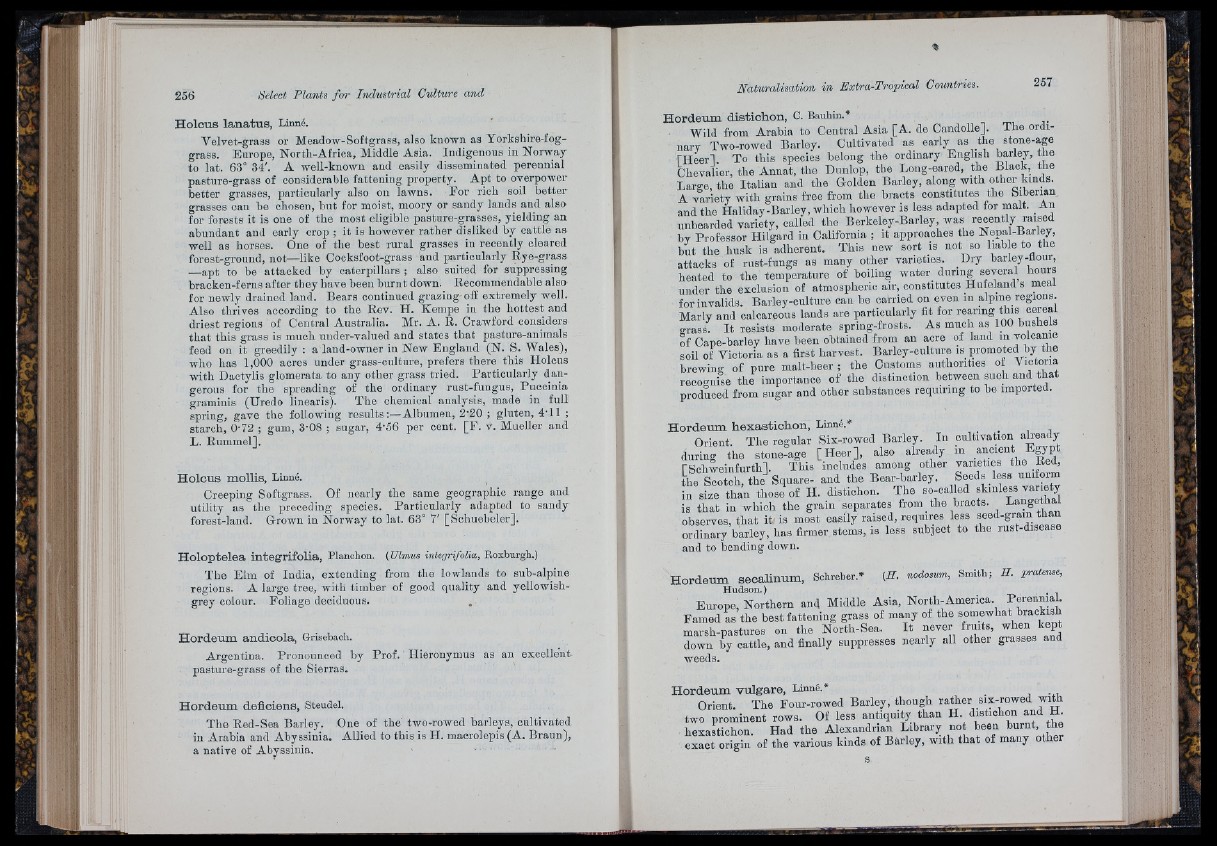
Select Plants fo r Industrial Culture and
Holcus lanatus, Linné.
Velvet-grass or Meadow-Softgrass, also known as Yorkshire-fog-
grass. Europe, North-Afriea, Middle Asia. Indigenous in Norway
to lat. 63° 34'. A well-known and easily disseminated perennial
pasture-grass of considerable fattening property. A p t to overpower
better grasses, particularly also on lawns. For rich soil better
grasses can be chosen, bnt for moist, moory or sandy lands and also
for forests it is one of the most eligible pasture-grasses, yielding an
abundant and early crop ; it is however rather disliked by cattle as
well as horses. One of the best rural grasses in recently cleared
forest-ground, not—like Cocksfoot-grass and particularly Rye-grass
—apt to be attacked by caterpillars ; also suited for suppressing
hracken-ferns after they have been burnt down. Reeommendable also
for newly drained land. Bears continued grazing ofE extremely well.
Also thrives according to the Rev. H. Kempe in the hottest and
driest regions of Central Australia. Mr. A. R. Crawford considers
th a t this grass is much under-valued and states th a t pasture-animals
feed on it greedily ; a land-owner in New England (N. S. Wales),
who has 1,000 acres under grass-culture, prefers there this Holcus
with Dactylis glomerata to any other grass tried. Particularly dangerous
for the spreading of the ordinary rust-fungus, Puocinia
graminis (Uredo linearis). The chemical analysis, made in full
spring, gave tlie following results:—Albumen, 2'20 ; gluten, 4T1 ;
starch, 0'72 ; gum, o'OS ; sugar, 4'56 per cent. [F . v. Mueller and
L. Rummel].
Holcus mollis, Linné.
Creeping Softgrass. Cf nearly tbe same geographic range and
utility as the preceding species. Particularly adapted to sandy
forest-land. Grown in Norway to lat. 63° 7' [Schuebeler].
Holoptelea integrifolia, Planchon. (Ulmus integrifolia, Roxburgh.)
'The Elm of India, extending from the lowlands to snb-alpine
regions. A large tree, with timber of good quality and yellowish-
grey colour. Foliage deciduous. .
Hordeum andioola, Grisebach.
Argentina. Pronounced by Prof. Hieronymus as an excellent
pasture-grass of tlie Sierras.
Hordeum defloiens, Steudel.
The Eed-Sea Barley. Cne of the' two-rowed barleys, cultivated
in Arabia and Abyssinia. Allied to this is II. macrolepis (A. Braun),
a native of Abyssinia.
Hordeum distichon, C. Bauhin.*
Wild from Arabia to Central Asia [A. de Candolle]. The ordinary
Two-rowed Barley. Cultivated as e a r l y as the stone-age
IH e e r]. To this species belong the ordinary English barley, the
Chevalier, the Annat, tlie Dunlop, the Long-eared, the Black, the
Large, the Italian and the Golden Barley, along with other kinds.
A variety with grains free from the bracts constitutes the Siberian
and the Haliday-Barley, which however is less adapted for malt. An
unbearded variety, called the Berkeley-Barley was recently raised
by Professor Hilgard in California ; it approaches the Nepai-Barley,
h L the husk is adherent. This new sort is not so Imb e to the
attacks of rust-fungs as many other varieties. Dry barley-flour,
heated to the temperature of boiling water during several hours
under the exclusion of atmospheric air, constitutes Hufeland s meal
for invalids. Barley-culture can he carried on even in alpme regions.
Marly and calcareous lands are particularly fit for rearing this cereal
grass. I t resists moderate spring-frosts. As much as 100 bushels
M C a p e - b a r l e y have been obtained from an aere of land '[i jolcanie
soil of Victoria as a first harvest. Barloy-cuiture is^ promoted by the
brewing of pure malt-beer ; the Customs authorities of Victoria
recognise the importance o f the distinction between such a n d th a t
produced from sugar and other substances requiring to be imported.
Hordeum hexastichon, Linné.* _
Crient. The regular Six-rowed Barley. In cultivation aReady
during the stone-age [ I le e r ] , also already m ancient E gypt
[Schweinfurth]. This includes among other varieties the Red,
the Scotch, the Square- and the Bear-harley. Seeds less uniform
in size than those of H. distichon. The so-called skinless variety
is th a t in which the grain separates f r o m the bracts. Eangetha
observes, th a t it is most easily raised, requires less seed-grain than
ordinary barley, has firmer stems, is less subject to the rust-disease
and to bending down.
(V Hordeum secalinum, Schreber.* . Smith; H . pratense,
Hudson.)
Europe, Northern and Middle Asia, North-America. PerenmaL
Famed as the best fattening grass of many of the somewhat brackish
marsh-pastnres on the North-Sea. I t never frnits, when kept
down by cattle, and finally suppresses nearly all other grasses and
weeds.
■ifr
Hordeum vulgare, Linné.*
Crient. 'The Four-rowed Barley, though rather six-rowed wito
two prominent rows. Cf less antiquity than H. distichon and H.
hexastichon. Had the Alexandrian Library not been ' ’umt, the
exact origin of the various kinds of Barley, with th a t of many other
s